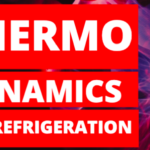In today’s lesson, we are going to discuss the following topics:
Purchase Tramadol Overnight 1. Gas Refrigeration Cycle, otherwise known as the Reverse Brayton, Reverse Joule, or Bell Coleman Cycle
Cheap Tramadol 4. Refrigeration Example
Purchase Tramadol Overnight 5. Regenerative Cooling
Notes and Assumptions:
(a) This whole process is internally reversible.
(b) There is no phase change throughout the entire cycle. The gas remains in gas form throughout.
(c) In this cycle, the most common refrigerant gas used is air.
Where is it used?
Because gas refrigeration cycles involve simple, lighter components, they are commonly used in jet aircrafts for air conditioning systems (using air from the engine compressors as the refrigerant).
How is it used? Here is a diagram with numbered steps:

(1) Compression
What happens?
The gas flows through a compressor in order to change the pressure, consequently changing the temperature.
How do Pressure, Temperature and Entropy Change?
When the gas is compressed, the pressure becomes very high. Because of this, the temperature also goes up. Entropy is constant (isentropic), due to the fact that we usually consider this system to be ideal.
Is there work input or output during this process?
There is work done on the system (the compressor) by the surroundings, so it is negative.
(2) Heat Exchanger
What happens?
The gas enters a heat exchanger. The gas loses heat which is removed from the heat exhanger by the amount QH (this variable is called the heating effect, in units of energy/mass like kJ/kg) in the image above.
How do Pressure, Temperature and Entropy Change?
Temperature of the gas decreases. The pressure stays constant (isobaric). Entropy decreases.
Is there work input or output during this process?
No work input or output.
(3) Turbine/Expander
What happens?
The gas enters a turbine (or an expander). Note that this step can also use a throttle valve or expansion valve.
How do Pressure, Temperature and Entropy Change?
This causes a sudden drop in pressure, consequently also causing a temperature drop. Entropy is constant (isentropic), due to the fact that we usually consider this system to be ideal.
Is there work input or output during this process?
Work is done by the system on the surroundings, so it is positive.
(4) Heat Exchanger (Specifically an Evaporator aka the refrigerator or the unit we are trying to cool down)
What happens?
The gas then enters this second heat exchanger. This is usually the unit, like a refrigerator, that we are trying to keep cool. The gas absorbs unwanted heat from the unit (eg. refrigerator). The absorbed heat is QL (the cooling effect, in units of energy/mass like kJ/kg) in the picture labelled above.
How do Pressure, Temperature and Entropy Change?
Temperature of the gas goes up. Pressure remains constant (isobaric). Entropy increases.
Is there work input or output during this process?
No work input or output.
(e) The gas then enters the compressor again and the cycle repeats.
Equations
COP is the Coeffcient of Performance, which I talk about in my Introduction to Refrigeration (click here for that). This is equal to qL (heat absorbed by gas in the refrigerator, which I talk about above) divided by net work into the system (Wnet, in).
The net work in the system can further be written as the work into the system by the compressor minus the work out of the system by the turbine (Wcomp,in – Wturb,out). Note that work done ON the system is negative (the system loses energy in this process) whereas work done BY the system is positive (the system gains energy in this process).
Parts of this equation can be broken down further into enthalpies. See the image of the refrigeration cycle near the top of the post to see the associated enthalpies with each subscript for that numbered phase of the cycle. To find the variables qL, Wturb,out or Wcomp,in – we can subtract the enthalpy out from the enthalpy in to that unit.

T-S Diagrams
T-S, otherwise known as Temperature-Entropy Diagrams (with temperature on the y-axis and entropy on the x-axis), give a visual representation of what’s happening to both variables along each phase of the refrigeration cycle.
When we have vertical lines (from units 1 to 2 and units 3 to 4, aka the compressor to heat exchanger 1 and the turbine to heat exchanger 2), we have constant entropy (isentropic) processes, while the temperature either increased or decreased.
Along the sloped increasing and decreasing lines, (unit 4 to 1 and unit 2 to 3) we have increasing or decreasing both entropy and temperature. This is consistent with what I explained earlier for each step. You may also see similar diagrams called P-V diagrams, which show pressure versus volume rather than temperature versus entropy.

Example

Let’s try the example above. We first need to assume some things – and these assumptions can usually be made with these types of questions. First, we assume that operating conditions are steady and do not fluctuate with time – that would make it pretty difficult to solve otherwise. We are also going to treat air as an ideal gas.
See the video at the top of the page to see a walkthrough of how to solve the problem!
Regenerative Cooling
Regenerative cooling is a concept with gas refrigeration. This is a method of cooling gas where compressed gas is cooled by allowing it to expand and thereby take heat from the surroundings. The cooled expanded gas then passes through a heat exchanger where it cools the incoming compressed gas.
It works by inserting a counter-flow heat exchanger into the cycle. Very low temperatures can be achieved with this method.
